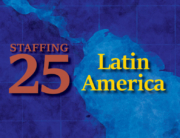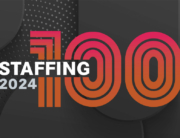The staffing industry left 2014 with a strong tailwind. An improving economy bolstered growth, and temporary help services jobs set record highs as a percent of total US employment.
But what trends will affect staffing in 2015?
Forecasts call for solid growth in two of the industry’s largest segments: IT and industrial. Experts say drivers include ecommerce, the skills gap and lingering buyer uncertainty. Statement- of-work contracts are also gaining popularity, and some see requests for greater accountability from staffing firms.
It’s not all fair weather. Compliance is more critical, wage-and-hour lawsuits more common. New laws mandate paid sick leave, minimum wage increases and more.
To gauge a few trends going into 2015, we interviewed staffing executives and checked the latest research.
Industrial’s Weight
Industrial staffing ranks as the largest single temporary staffing segment in the US, according to research by Staffing Industry Analysts. It also grew faster than the overall staffing industry in four of the last five years.
US industrial staffing revenue rose 6% to $31.3 billion in 2014. It’s forecast for similar growth this year.
Lesa Francis, president and CEO of industrial staffing provider Staff- mark, cites several factors encouraging use of industrial temporary workers — including ecommerce and its use of warehouse workers.
“Ecommerce is really driving a higher use of temporary employees because people are trying to look at the rhythm of when the orders are coming in and asking what days do I need people?” Francis says. “The ability to use temporary employees allows these companies to be more flexible and responsive to the needs of their customers.”
Other drivers of industrial staffing growth include lingering uncertainty about the economy and the skills gap, Francis says. Economic uncertainty remains despite the late stage of the recovery, and companies also go to staffing firms to find skilled workers they can’t find themselves.
Users are looking at cost, time savings, flexibility and risk mitigation when bringing in staffing firms, says Jason Leverant, president and COO of industrial staffing provider AtWork Group.
Risk mitigation is one factor that can especially impact small- and midsized staffing users who would otherwise face the increasing regulatory environment on their own, Leverant says. These regulations include the Affordable Care Act, minimum wage increases and paid sick leave laws.
“Keeping up with these components can be extremely problematic for small to midsize organizations,” he says. “That’s where they are seeing a lot of value with a staffing firm.”
However, these can be a double- edged sword as staffing firms must also keep up. Although the ACA is getting much press, paid sick leave laws can be especially problematic, Leverant says. These laws are enacted by cities and states, so they vary by location.
Wage-and-hour lawsuits are also seen as more common, experts say. And they provide another reason for firms to make sure they are compliant.
IT Is Still Sunny
IT staffing also looks relatively sunny. Staffing Industry Analysts forecasts US information technology temporary staffing revenue will increase 7% in 2015, the sixth consecutive year of growth.
“The market has been anywhere between good and great for about the last two to three years,” says Ingram Losner, co-founder of IT staffing firm PROVEN.
Tech suffered along with everyone else in the downturn, but the segment has a tremendous ability to reinvent itself and bounced back faster than old economy industries, Losner says.
From a micro perspective, companies have been upgrading architecture once left to sit because of cost cutting. In addition, they are looking at next phases of technology — including ecommerce and the interrelationship between technology and social media. “Social media vehicles have clearly driven the latest wave of development,” Losner says.
Mobile technology is also growing.
“The other trends are cloud technology, analytics, big data, the inter- relationship between technology and marketing, all of the tools that go into those particular areas,” Losner says.
Ranjini Poddar, president of IT staffing provider Artech Information Systems LLC, also says companies that held back on committing to IT projects are moving forward again.
“Now there is some positive outlook as far as the economy is concerned,” Poddar says. However, hesitation is still evident in some areas as memory of the downturn remains, she adds.
Dark Clouds
One concern: the ongoing skills shortage, or mismatch between skills employers need and skills workers have.
“The supply shortage is still there and expected to increase, especially for very much in demand skills,” Poddar says.
H-1B visas used to bring in highly skilled individuals such as technology workers are capped at 85,000. Legislation has been introduced to raise the cap, but it remains in place for now. President Obama also announced changes to immigration, but it’s uncertain whether those will help.
“I think as far as the steps the president is proposing, it’s difficult to tell how it’s going to play out until we actually see what is implemented,” Poddar says.
The ACA might encourage more IT professionals to take temporary positions because they will have healthcare, but its impact in this area is also uncertain, she says.
PROVEN’s Losner says things will only get more challenging as far as the skills mismatch is concerned.
“There’s just not enough kids with the appropriate disciplines coming out of schools to satisfy the growing and exceptional demand for these critical, technology-centric skill sets,” he says. “And this, of course, is being further exacerbated by the political gridlock in relation to the limits on H-1Bs and with the baby boomer generation retiring.”
Artech’s Poddar says another trend is a focus on cost by some users, but cost-cutting won’t necessarily be effective as demand increases while the skills gap constrains supply.
A focus on cost and commoditization is seen in other areas of staffing as well.
“A lot of buyers are constantly trying to drive down the cost,” says Staffmark’s Francis. However, for every margin dollar taken from staffing firms, there are less dollars to invest in creative recruiting and matching workers with companies.
“I think the customer views it as cutting my costs versus looking at ‘am I allowing the staffing firm I’m working with to have a fair rate that allows them to really help us find the quality people we need to help our business grow?’” Francis says.
There are other trends on the horizon that impact how staffing firms provide talent. One is accountability.
Francis says she sees a trend among some buyers for increased accountability of staffing suppliers for the work of their contingent employees. For example,
Staffmark has a division that can send both workers and managers to customer sites and bill the buyer by units touched or units shipped instead of hourly rates.
“For instance, you might have a customer putting together a group of packets to be mailed out,” Francis says. “We might charge the customer for every piece of paper we have to touch. We bill them on a piece rate versus the hourly rate you’d charge if you were just sending them employees. And we actually manage the employees that are putting those packets together.”
This type of billing changes by contract, but such deals are complex. Staffing firms typically must have an investment in engineering support to be successful in such operations.
Techno Winds
Continuous developments in technology shape trends and have an impact on staffing.
Social media — including Facebook Twitter and Instagram — continue to bring new ways to recruit, and workers have adopted to mobile devices. AtWork’s Leverant says even industrial workers have smart phones, and it will be up to staffing firms to take advantage of the new mobile technology. Someday, given proper privacy protections, smart phones may even be able to let staffing firms know if a worker has appeared on a job site by using geo location services.
For IT firms, of course, the hot trends and jobs that need to be filled are driven by the speed of Silicon Valley.
Trends and hot markets, in general, keep changing. 2015 seems off to a good start, but staffing firms will need to keep an eye out for new trends. With the ACA, technology and the global economy, the future can be hard to predict.







